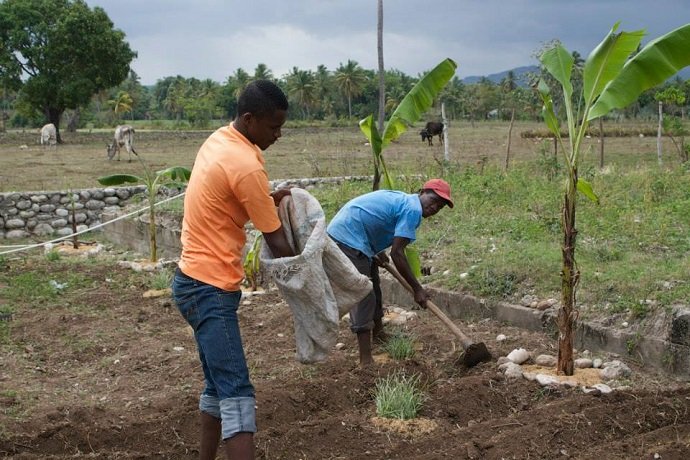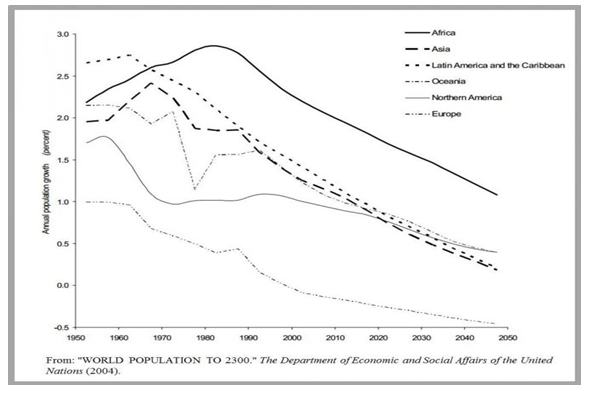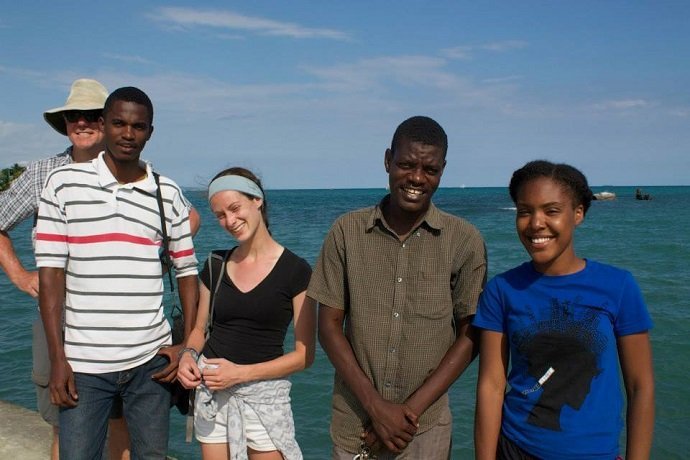
When teaching permaculture I often start out by doing a giant problems mind map. I ask students to brainstorm all of the major “problems” they see in the world to reflect on what brought them to study permaculture. Nine times out of ten the idea of overpopulation as a root “problem” in the world comes up.
Overpopulation describes a situation where there are too many people for the amount of resources available. It puts the blame of the environmental crisis on the sheer number of people on the planet.
Natural scientist and former senior manager of the BBC David Attenborough sums up this sentiment when he said, “We are a plague on the Earth. Either we limit our population growth or the natural world will do it for us[.]”
This cultural narrative, that human beings are the root cause of the environmental cri-sis is everywhere, especially among environmentalists. We also see this belief within permaculture design. The third ethic of permaculture reads:
Setting limits to population and consumption: By governing our own needs we can set resources aside to the above principles.
Not only is this idea of overpopulation oversimplified and inaccurate, it upholds a de-generative paradigm of scarcity, fear and competition that goes against the core teachings of permaculture. It also perpetuates problematic thinking that leads to ineffective and unjust public policies and global solutions. As permaculturalists, it is important that we contradict this notion that simply more people on the planet equals less resources and more pollution. We need to engage in dialog around the true roots of environmental, social and economic degradation. In this way, we can begin to shift mental models and design more effective and just solutions that take into account the real root causes of degradation and injustice.
In his book Permaculture: Principles and Pathways Beyond Sustainability, David Holmgren reframed the third ethic as “fair share” or “redistribute the surplus.” He points out the paradox of permaculture’s core belief of abundance and this ethic. He states that, “Except in extreme famine and other natural disasters, scarcity is a culturally mediated reality; it is largely created by industrial economics and power, rather than actual physical limits to growth.”
Although the third ethic has been reframed, there has been little discussion about this shift in the permaculture community or literature on how to address and refute the myth of overpopulation in the first place. I created the following talking points that we can use when having discussions around overpopulation.
6 Talking Points for Permaculturalists to debunk the myth of overpopulation:
• Rates of population growth are declining: Between 1950 and 2000, the world population grew at a rate of 1.76%. However, between 2000 and 2050, the rate of growth is expected to decline to 0.77 percent. A UN report titled “World Population to 2300” paints a picture of Europe’s future if European fertility rates don’t rise above current levels: “The European Union, which has recently expanded to en-compass 452-455 million people (according to 2000-2005 figures) would fall by 2300 to only 59 million. About half the countries of Europe would lose 95 per cent or more of their population, and such countries as the Russian Federation and Italy would have only 1 per cent of their population left.”
• Overpopulation is defined by numbers of people, not their behaviors: Industrialized countries, who make up only 20% of the worlds population, are responsible for 80% of the carbon dioxide build up in the atmosphere. The United States is the worst offender with 20 tons of carbon emission per person. Therefore it is not just the amount of people that leads to degradation but what they are doing. Permaculture design illustrates how humans can be a keystone species and have a positive impact on the health of our ecosystems, bringing greater health and equity. We can depave the way for industrial retrofits and regenerative development.
• Overpopulation justifies the scapegoating and human rights violations of poor people, women, people of color and immigrant communities: Often times the subtext of “too many people” translates to too many poor people, people of color and immigrants. In the 1970’s Puerto Rico, under the control of and with funding from the US government , forced the sterilization of 35% of women of child bearing age . This is a human and reproductive rights violation. It also prevents us from dealing with the real social, political and economic origins of our ecological problems and places the blame on communities with less institutional power. This perpetuates a fear mindset, keeps people divided and blaming each other rather than being able to come together to organize for true self determination and security.
• Overpopulation points the finger at individuals not systems: This lets the real culprits off the hook. When we look at the true causes of environmental destruction and poverty it is often social, political and economic systems, not individuals. We see militaries and the toxic legacy of war, corrupt governments, and a capitalist economic system that puts profit over people and the environment. The founder of Social Ecology, Murray Bookchin said, “If we live in a grow or die capitalistic society in which accumulation is literally the law of economic survival and competition is the motor of progress, anything we have to say about population being the cause of ecological crisis is meaningless.
• Supports a degenerative mental model of scarcity: Much of this ideology was created by Thomas Robert Malthus, an 19th century english scholar, whose work influenced the fields of political economy and demography. Malthus gave us the idea that the reason there is famine is because there are too many mouths to feed. In his 1798 essay, An essay on the principle of Population, he goes on to say that it was human population that causes food prices to rise and therefore is the root cause of famine. Malthus was extremely influential to Charles Darwin in his thinking around “Survival of the Fittest.” His work was also used as the philosophical bedrock to justify many human rights violations such as the eugenics movement, forced sterilization, and even the Holocaust.
• Focusing on overpopulation prevents us from creating effective solutions and building movements for collective self determination: We know from the permaculture design process how we define a problem determines how we design solutions. How does viewing overpopulation as a root problem impact the way we think of and design solutions? What would solutions look like if we viewed people, all people, as an asset? The myth of overpopulation has lead to solutions of population control and fertility treatments, rather than overall health care and women’s rights. . The more we blame humans, think we are bad and evil, the harder it is to believe in ourselves, count on each other, and build a collective movement for jus-tice and self determination. Scholar, scientist and activist, Vandana Shiva said, “Hunger and malnutrition are man-made. They are hardwired in the design of the industrial, chemical model of agriculture. But just as hunger is created by design, healthy and nutritious food for all can also be designed, through food democracy.”
Together we can dispel the notion that overpopulation is a root cause of environmental degradation and deepen the discussion about the switch of the third ethic from setting limits to growth and population to fair share/redistribute the surplus. We can form new mental models that can lead to widespread, lasting social change and more effective and just solutions for collective health and abundance.
References
Thomas, Trevor, “The Myth of Overpopulation”, American Thinker, February 10, 2013
Mollison, Bill, Permaculture A practical Guide for a Sustainable Future (Covelo: Island Press, 1990).
Holmgren, David, Permaculture Principles and Pathways Beyond Sustainability (Hepburn: Holmgren De-sign Services, 2002).
“WORLD POPULATION TO 2300.” The Department of Economic and Social Affairs of the United Nations (2004): https://www.un.org/esa/population/publications/longrange2/WorldPop2300final.pdf
Hartman, Betsy. “10 Reasons Why Population Control is Not the Solution to Global Warming,” https://popdev.hampshire.edu/sites/default/files/uploads/u4763/DT%2057%20-%20Hartmann.pdf
The Chicago Womens Liberation Union. https://www.uic.edu/orgs/cwluherstory/CWLUArchive/puertorico.html
10 Reasons to Rethink Overpopulation. https://popdev.hampshire.edu/projects/dt/40
Shiva, Vandana, “The Real Hunger Gamers”, Asian Age, August 29, 2012
















I love this article! So succinct. Thanks so much. :-)
There no so blind a those who will not see. Your utopian view of a solution which logic would say ends in the catastrophic destruct of natural ecosystems. There are so many inconsistences in you article. It would take days of debunking. To say slowing growth in population is some how a positive is like “I am polluting the seas but not much a I did but still beyond the ability of the sea to recover.” Over fishing, Forest clearing and water pollution just three that are not sustainable with exiting population. Permaculture is a great process but not the solution , more people more resources a simple equation. Wild environment is our only savior and population need to be reversed. Humans have become “the lice on the body of the world” Parasitic effects will kill the host
Much of what you say is true, about redistribution, but the industrial system that now controls distribution globally is almost beyond anything but elite control. And that system is putting in processes to disorganise and explode populations all over the world – through wars that destroy economies causing mass exodus and directing those flights through global land-sales and citizenship commodification. The population trends you use to say that world population is going down are only trends, based on past performance and the so-called demographic transition. They do not rely on any population science, only arithmetic and maths, without any sound theoretical roots. Usually they couch their ‘predictions’ within the dogma of the ‘demographic transition’. But the demographic transition ‘theory’ fails to take into account mass immigration, which is now cumulatively swelling ‘developed’ settler countries like Australia, the United States, Britain, and Canada in just the same way it disorganised and inflates the populations of Africa, India and the Pacific and in just the way the colonising populations disorganised and displaced earlier inhabitants who basically used permaculture and had small populations.
Where once tribes had kinship rules and cooperative breeding structures that limited fertility opportunities, now these cultural limits have been destroyed and tribes meet in huge cities, generally after governments have destroyed traditional land-tenure systems in favour of ‘efficiency’ and industrial cropping. People then have no choice but to look for pitifully waged work in mines or in cities in factories and servitude. Add to this the lack of effective child labour laws and you motivate people to maximise their pitiful earnings by deploying children as income earners. (Doepke comparing Korea and South America).
This urbanisation and population exploitation process rose in Holland and Britain in the 16th and 17th centuries. Many countries in the world had competed in the trade wars by land and, famously by sea from the late 15th C using slave migration to replace indigenous populations in places like the then rich and beautiful island of Haiti. The major products were slaves and gold. That is what pre-industrial ‘civilisation’ is built on. Britain with her confluence of coal and iron and industrial smelting came to dominate the trade wars and she colonised whole countries and rewrote their inheritance, land-tenure and land-use laws.
In the 1970s, with the oil shocks, the anglosphere began to undercut democracy for its citizens, to borrow to expand and to wreck industrial protection systems to bring down wages and outsource labour and production to ‘developing’ countries where people were turfed off their land and driven into factories in the name of ‘development’. In continental Europe citizens had more rights due to the civil codes established through the French revolution. But those rights are threatened by anglophone encroachment via the EU.
From the 1990s this process has again been hugely expedited by the capacity to buy and sell land internationally via the internet in the anglophone system. (The Roman Law system of continental Europe has some defenses against this, although the EU is a vehicle for Americanisation of european law, intending to privatise profits and externalise costs which have previously been obvious to states and citizens.) This land-selling and usurping is now rife in the so-called ‘developed’ countries. The value of land is being driven up in those countries by the simple process of forced population growth and land-subdivision. Australia, where permaculture originated, is mostly desert and very fragile land. It is being taken over by land-barons. In the 1980s Australia’s population was 17m. But it is on course to double and triple because the land-barons want populations of about 250m – simply because this creates demand and and they can focus the benefits to a few elite via simplified profit systems. Australia’s political parties are really giant land corporations, imposing massive economic immigration on their own population. In Melbourne, which has 4m people, these corrupt governments are planning for 10m plus in thirty years! In order to impose this on a baffled and horrified populace, they are about to privatise the land-use planning systems so that the ‘citizens’ will not retain any pesky land-rights to stop continuous subdivision and the repopulation of the land several times over.
So it is all a little more complicated than the way the demographers tend to present it.
For documentation check out two books by Sheila Newman, Demography Territory Law: Rules of Animal and Human Populations and Demography Territory Law 2: Land tenure and the Origins of Capitalism in Britain. https://candobetter.net/node/1882
Population earth increases every year with officially 80 millions pepole (probably more). CO2 is linked with human activities and climate changes are accelerating. The glaciers melt and the increase of the mass of water in the oceans or the relaxation of pressure on lands change the pressure on tectonic plates. Hence more landslides, earthquakes and volcanic eruptions. Those are facts. And when you consider that we pollute everything, kill thousands of species in fauna and flora, destroy the forests, human population on earth must decrease by limiting births.
Puerto Rico “under the control of and with funding from the US government forced the sterilization of 35% of women”? Sorry but “forced” and “sterilized without ever informing the women” are two different things. Forced would have meant that people could have resisted. Let get real, Bill Gates FATHER ran the program, as far as I am concerned he was the US’s Josef Mengele, using US CITIZENS as his guinea pigs. Lucky for my brother I was born just before the program stated. Women went to deliver, put under anesthesia and sterilized, left wondering why they could not get pregnant. And lucky for my son that it ended before I had my daughter. Or at least that’s what we were told. I remember how my gynecologist/pediatrician kept insisting how it was imposible that I had a miscarriage (followed by his suicide not many days after) until I describe exactly what came out. I guess he couldn’t figure out how I managed to get pregnant twice after my daughter.